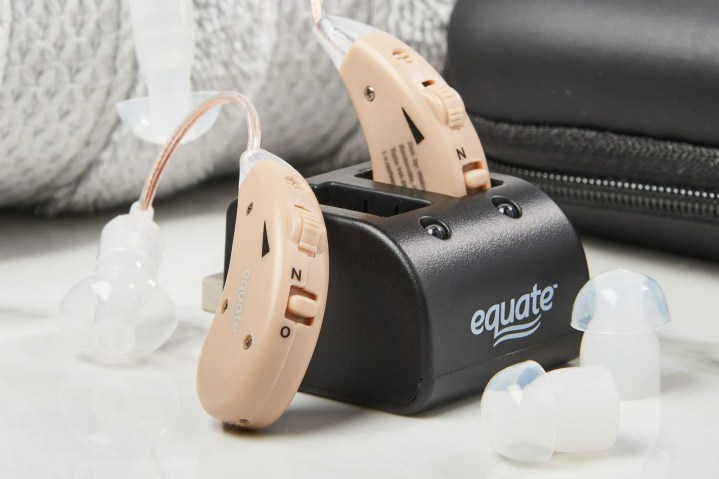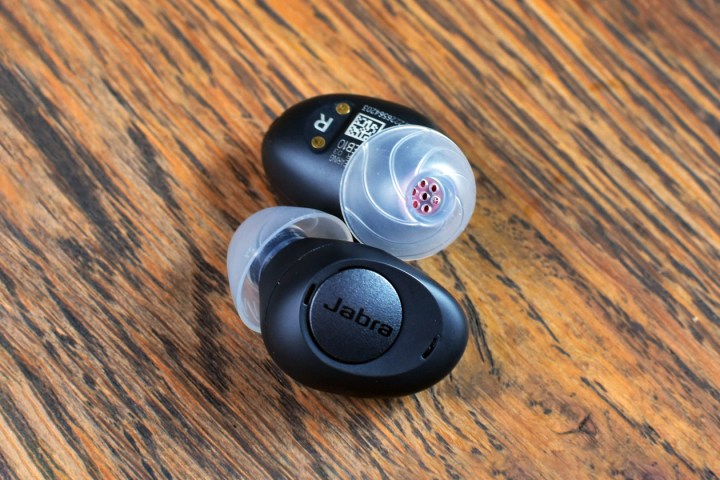Maybe you spent a few too many nights at ear-bleeding rock concerts in your younger days, ignoring your parents who begged you to wear some earplugs. Or maybe you’ve worked in a noisy environment for years and didn’t take care to wear ear protection. Or maybe you’re just getting older and having trouble hearing like you used to. You’re not alone. According to the National Council on Aging, roughly 25% of Americans between 65 and 74 have hearing loss that impacts their daily life, and the National Institute on Deafness and Other Communication Disorders says that 15% of those 18 and older have some issues hearing properly.
- What are over-the-counter hearing aids, and who are they for?
- What’s the difference between over-the-counter and prescription hearing aids?
- Hearing aid or amplifier: what’s the difference?
- What types of over-the-counter hearing aids are available?
- How to get OTC hearing aids
- Can over-the-counter hearing aids qualify for insurance coverage?
- What about the maintenance of over-the-counter hearing aids?
Until October 2022, the only recourse for anyone with hearing loss of any kind was to see an audiologist or doctor for an examination to determine if prescription hearing aids were necessary. Luckily, things changed that October when the FDA opened things up, making it possible for those with perceived mild to moderate hearing loss to purchase over-the-counter hearing aids without a prescription or examination.
The market responded, with major headphone and earbud makers such as Jabra, Sony, Bose, and others offering up affordable and feature-rich OTC hearing aids, often in conjunction with some of the best hearing aid makers in the world. And the market continues to grow, making OTA hearing aids a viable alternative that could provide hearing benefits where none were possible before.
Here’s what you need to know about OTC hearing aids and some tips on how to buy them.

What are over-the-counter hearing aids, and who are they for?
According to the FDA, over-the-counter hearing aids are hearing devices that are aimed toward those with mild to moderate hearing loss and are intended for use by adults 18 years and older. They’re available to consumers without a prescription or exam from an audiologist, ear-nose-throat (ENT) doctor, or licensed hearing health professional. Those with more severe hearing loss or those unable to determine their level of hearing loss on their own should seek medical help and/or look for prescription hearing aids instead.
Over-the-counter hearing aid models, compared to their prescription counterparts, are a bit more limited in what kind of hearing loss they can handle (their maximum sound output peak is limited compared to prescription hearing aids). However, many OTC hearing aids have features that allow control and fine-tuning through software, such as a smartphone app, and many are self-fitting and offer self-assessment features.
What’s the difference between over-the-counter and prescription hearing aids?
So why are over-the-counter hearing aids such a big deal over hearing aids that require a prescription? The difference can be summed up in a few important points:
- Affordability: Over-the-counter hearing aids are much more affordable than their prescription counterparts. Prescription hearing aids can cost several thousand dollars or more, which puts them beyond the reach of those who don’t have insurance that will cover them. Over-the-counter models, on the other hand, typically start at around $800 to $1,500.
- You don’t need a hearing exam: Over-the-counter hearing aids don’t require the same exams, fitting, prescriptions, or maintenance requirements as prescription models, which can also save a lot of time and money.
- Availability: Over-the-counter hearing aid models are easier to find. You don’t have to go to a specialized hearing care clinic to purchase them. You can visit common retail websites and order them in just a few minutes if you want
- Extra features: Over-the-counter hearing aids may come with extra features for consumer use — such as Bluetooth capabilities for connecting to devices for audio playback, and app accompaniment for further customization — that prescription models may not have.
Hearing aid or amplifier: what’s the difference?

Choose a hearing aid or an amplifier. An amplifier boosts and relays nearby sounds so they can be heard more easily. They don’t have many other hearing aid features, and are only suitable for slight hearing loss. But they are much, much less expensive than true hearing aids, usually starting at around just $50, so it’s a way to save money.
Hearing aids start at several hundred dollars and can go up to a few thousand. They have more complete tuning, customization, amplification, treble and bass settings, and more. They’re a better fit for directly addressing hearing problems that are starting to interfere with daily life.
What types of over-the-counter hearing aids are available?

Over-the-counter hearing aid models typically come in three different design options, each with their own advantages:
- Earbud models: These look like traditional earbuds that you might buy from Sony, Jabra, Apple, or other brands — and some are even offered by the same companies. The advantage, of course, is that it looks like you’re just wearing normal earbuds, and like today’s wireless earbuds, they are very easy to charge and use as needed.
- In-ear, low-profile models: These are designed to be as hidden as possible and are often available in skin colors to better mask them. The goal is to make it seem like they aren’t there at all. However, the small size typically means lower battery life and more limited use. They may also be more expensive.
- Behind-the-ear models: These come with a tiny earbud that’s connected by wire to a larger component that rests behind the ear. This is a more complicated, unwieldy setup that’s much more noticeable. However, you get more battery power and generally better hearing features, so they tend to be a better pick for more moderate hearing loss.
How to get OTC hearing aids
First, arrange a hearing exam with your doctor. Wait, but you just said — we know, we know, you don’t technically need a hearing exam to buy over-the-counter hearing aids, and that’s one of the advantages. But if you think you have hearing loss and you haven’t talked about it with your doctor yet, you really need to. It’s important to get a hearing exam to judge the extent of your hearing loss, and if over-the-counter models are the right choice for you. A hearing specialist may even be able to recommend certain brands or stores to try.
Next, find a retailer’s site or store that has your preferred hearing aid in stock. We suggest heading online for this step. You’ll find a lot more options in stock, and you can use regular payment methods that you may have already set up. Popular stores include:
Once you have found a pair of OTC hearing aids that you want, you can simply place them in your cart like any other purchase. There are no additional hoops you are required to jump through to buy them. Note that some models may only be available online, while others may not always be in stock, so remember to check the details as you check out.
Can over-the-counter hearing aids qualify for insurance coverage?
Insurance isn’t directly covering OTC hearing aids this time. However, many of the models are qualifying purchases for Flexible Spending Accounts, Health Savings Accounts, and other specialized accounts that you can use to help save money on taxes and gain other benefits.
What about the maintenance of over-the-counter hearing aids?
There is no counseling for caring for over-the-counter hearing aid models, so read the manual carefully. Fortunately, brands like Lexie already have guides on when and how to clean your hearing aids that will apply to over-the-counter models too. Don’t use any kind of water or cleaners on your hearing aids to avoid damage. For frequent cleaning, you may want to pick up a specialized tool.
Editors' Recommendations
- Best over-the-counter hearing aids for 2024
- CES 2023: New Sennheiser wireless earbuds help you hear better in noisy places
- HP is now in the OTC hearing aid game, powered by Nuheara
- Sony to bring over-the-counter hearing aids to the masses
- Olive Max provides low-cost alternative to hearing aids






